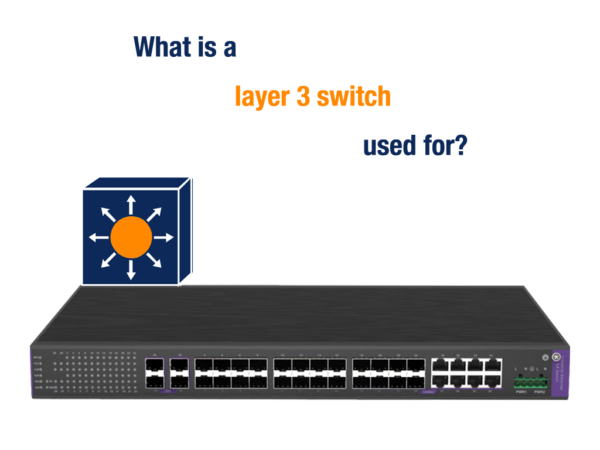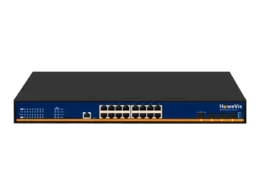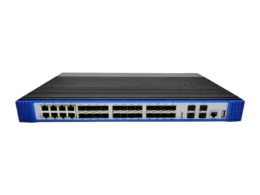Hundreds of data applications simultaneously process data and provide valuable insights in data centers. We need to supply high-speed data connections without any interruptions at such a place. Do you know why? A cut in data connection leads to the stoppage of the whole work. This scenario and slow-speed data are significant enough to stop the work.
Do we have a solution? Yes, there is. Power over Ethernet is available for such purposes to supply data up to 1 gigabyte—1 GIGABYTE PER SECOND. That’s just incredible! Even 10 gigabytes per second is possible with this technology. In PoE, you connect multiple devices and provide them with power through an Ethernet cable. Do you know how you connect your devices and route your data? For this reason, we use Ethernet switches.
For a detailed analysis of PoE, you can follow the guide— What is PoE?
What is a layer 3 Ethernet switch?
I have a question before proceeding to the topic. How much do you know about a network switch? Maybe you have it in your office or home. Especially at data centers, you can find these network switches. In actuality, network switches connect multiple devices, provide them with the data supply or power, and make them act as a single device. I believe it is pretty easy to understand the layer 3 switches.
Layer 3 is an Ethernet switch that procures routing functions for high data speed over a local area network. These switches receive incoming packets, inspect them, and forward them to the devices for effective data exchange. Nowadays, Layer 3 switches work because they have some routing functions and networking.
How does a Layer 3 switch work?
That’s a pretty good question. It would be best to ask such questions while coming up with these things. Layer 3 switches work at two basic levels—Layer 2 and Layer 3. At the layer 3 level, they perform their action in two ways.
Packet by Packet Layer 3 Switches:
- These switches receive the data packets from a network and analyze its destination IP address — the device address it will go to. These switches work like routing devices instead of just manipulating software. Before forwarding the packet to the destination devices, these switches perform integrity checkups and duration after each hop. These might communicate using routing protocols such as Routing Information Protocol (RIP) or Open Shortest Path First (OSPF).
Cut-Through switches:
- These switches do a straightforward job. They analyze only the first packet in a series of packages, understand its destination address, and forward the packets using the MAC address(physical address of devices).
As I mentioned, the Layer 3 switch can function as a Layer 2 switch by bridging devices over the same network. This allows you to connect your devices.
What are the significant features of Layer 3 switches?
The Layer 3 Ethernet switch has several different features. These collectively perform the network’s function and connect the devices. However, let me list some significant points regarding the Layer 3 Ethernet switch to help you understand it fully.
- Just like an Ethernet switch, the Layer 3 switch procures 24 Ethernet ports. Quite awesome.
- No WAN interfaces— WAN stands for Wide area network.
- It acts as a layer 2 switch to bridge the connection between multiple devices and connect them.
- Performs activity as a switch along with routing IP intelligence
- Works on two OSI layers, Layer 2 and Layer 3.
What is the layer 3 switches used for?
Here we are, where we started our article. There are many questions regarding the use of layer 3 switches. There is much confusion among people because there are layer 2 switches available for networking. So, why use layer 3 switches? Let me tell you the reason.
With layer 2 switches, we only create the bridge between the devices and connect them through a single network. What does that mean? We only connect devices, and this does not improve performance. Moreover, this scenario works only for low to medium traffic. So, does our network have high traffic? That’s a severe problem because performance will be low, right? Why not have a solution? We use routers. However, routers don’t improve the quality of traffic and performance as expected.
Nowadays, an advanced solution is available in a Layer 3 Ethernet switch. It not only performs the layer 2 function but also acts as a router without decreasing the network’s performance.
So, the layer 3 Ethernet switch is perfect for high-traffic networks.
What are the advantages of using Layer 3 Ethernet Switch?
You must know the background if you consider using the Layer 3 switch. Why is it better than Layer 2? Why should you employ it in your system for networking? No worries; let me list all the advantages you can get from the Layer 3 Ethernet switch.
Dual Functions:
The layer 3 Ethernet switch is a two-in-one package. It integrates all your network devices and allows data speed over the same network. Moreover, it offers special routing for your devices and analyzes the incoming data packets before forwarding them.
Uses IP address for better networking:
Layer 2 switches use the MAC address to transfer the data packets from one device to another. Compared to it, Layer 3 switches work best with the MAC address, which is a better option.
Improves performance:
The router’s performance decreases at high traffic. Layer 2 switches are best for low or medium traffic. To boost network performance over high traffic, we use the best Layer 3 switches.
Saves cost:
As I stated, layer 3 switches are best for networking and routing data. This reduces the cost of purchasing multiple hardware—layer 2 switches and routers—and increases the performance of the whole network. That’s why we use them in our networks.
What are the disadvantages of the layer 3 Ethernet switch?
Before purchasing a product, what do you do? A thorough analysis, right? Why not make the informed decision while choosing the layer 3 Ethernet switch? That’s why I have listed all the disadvantages and advantages of the layer 3 Ethernet switch. List your requirements and compare them with the product features to make the right choice. That’s how I love to choose the product. Here are some disadvantages of the layer 3 Ethernet switch as well.
- Layer 3 switch works better for many devices over the Local Area Network. However, it may increase the complexity of smaller networks.
- Due to multiple functions, the layer 3 switch may be inexpensive if you are short on budget.
- Only one VLAN can use the one switch. This restriction is the major drawback of layer 3 switches.








